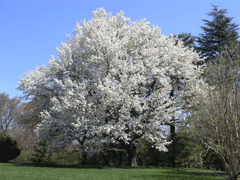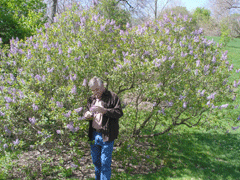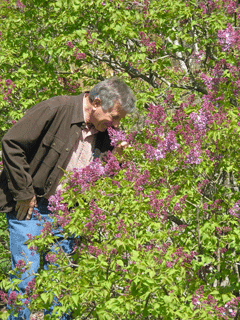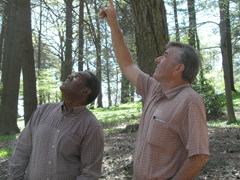Growing in a Changing Climate
Air Date: Week of May 11, 2007

A pear tree. (Peter Del Tredici)
As Harvard University’s Arnold Arboretum prepares for its annual Lilac Sunday, senior scientist Dr. Peter Del Tredici takes Living on Earth host Steve Curwood on a tour to demonstrate how acid rain and climate change are affecting the arboretums’s plants and trees.
Transcript
[BIRDS SINGING]
CURWOOD: Take a lush hillside topped with tall Hemlock trees; plant a collection of more than 15,000 varieties of other trees, shrubs and woody plants collected from all over the world. Toss in a magnificent view of the Boston skyline and you’ve got the Arnold Arboretum. Harvard University maintains the Arboretum as a public park for the city of Boston, a place that’s high on the list of school field trips when spring ignites the park with a dazzling display of fragrance and blooms.
[TRUCK DRIVING]
CURWOOD: On this spring morning some work crews are out spraying oak trees with a bacteria that kills insects. Others fan out to snip and prune in advance of the Arboretum’s biggest event of the year – Lilac Sunday.
[BIRD SOUNDS, SAWING SOUND]
CURWOOD: More than 200 different varieties of the fragrant blooms will be on display on Lilac Sunday. We’ve come to Arnold Arboretum to talk with its Senior Research Scientist Peter Del Tredici. He says in recent years the big day has become something of a moving target.
DEL TREDICI: Traditionally, at the arboretum, Lilac Sunday was around the third Sunday in May, somewhere between the you know 20th 22nd and 23rd. But about 15 years ago we realized that most of the lilacs had already gone by the time Lilac Sunday had arrived so we shifted the date up and we now celebrate Lilac Sunday here at the arboretum on Mother’s Day.
[MUSIC Sora “Spring” from ‘Kalk Seeds: A Karaoke Kalk Compilation’ (Karaoke Kalk – 2005)]
CURWOOD: So, why is that happening do you think?
DEL TREDICI: Well, all you have to do is pick up the newspaper and chances are there’s going to be some story about climate change. And the blooming of the lilacs which is really a temperature response is one of the signs that the weather has been changing, particularly here in the Boston area since the 1970s.

Arnold Arboretum Senior Scientist Peter Del Tredici. (Photo: Steve Curwood)
DEL TREDICI: Things are getting warmer earlier.
CURWOOD: Now what about the fact that there’s more carbon dioxide in the atmosphere. That’s a fertilizer for plants.
DEL TREDICI: Well that would affect how quickly things grow, how vigorous they are. It wouldn’t necessarily affect when they bloom. So in other words if you look at the amount of rag weed or poison ivy that’s proliferating along the roadsides you might be able to say that that might have something to do with carbon dioxide enrichment but in terms of blooming times I don’t think that has anything to do with CO2.
CURWOOD: But wait a second. You’re saying that the weeds are taking advantage of the more CO2. We might have more weeds as a function of this?
DEL TREDICI: Well, that is one of the predicted effects of climate change. Certain plants are more efficient at being able to turn carbon dioxide into carbohydrate. And the weeds seem to be particularly good at that.
CURWOOD: Let’s take a closer look at one of these lilacs. Now unfortunately I haven’t figured out how to get my microphone to record the smell but…
DEL TREDICI: Well, that is unfortunate. That is really sad. Well this one is [sniffs] it’s got a ways to go. You know every plant here at the arboretum, one of the things that’s really terrific, is everything is labeled here. This particular plant, Seringo vulgerous, this is President Lincoln. This is a very, an American selection from the 1800s, the late 1800s, early 1900s. This plant is from 1995 and is considered to be one of the bluest of the lilacs. A really beautiful plant, and it will be in full bloom, ah, you know if the weather stays warm, particularly at night it might even be in bloom for lilac Sunday.

Dr. Peter Del Tredici stops and smells the lilacs.(Photo: Steve Curwood)
CURWOOD: What else has really changed for these plants over the last 100 years at our Arnold Arboretum?
DEL TREDICI: The other thing that’s happened, and this is intensified because we’re in the middle of a city basically, is that one of the byproducts of increasing CO2 in the atmosphere is acid precipitation. And we have the soils here at the arboretum is the ph has been dropping precipitously over the last 50 years and you know we have to put a lot of lime on the soil to counteract the negative impact of acid rain. Lilacs are a lime-loving species and so this area in order to maintain its health we have to put a lot of limestone on these plants.
CURWOOD: Are you loosing plants because of these changes?
DEL TREDICI: The acidification of the soil is sort of one of these hidden things that is clearly a byproduct of burning of fossil fuels. And what happens when you lower the soil’s pH is that certain nutrients that are available to the plant at higher pH become unavailable. And aluminum becomes toxic at lower pHs and so if you change the soil pH that really changes the whole health status of the plant. So in terms of… they become more susceptible to diseases, because they can’t get the right nutrients out of the soil. So it’s one of those factors that really contributes to the general decline of vegetation. And so bringing that pH back up to, you know, above a pH of five, five and a half, is really critical to maintaining the long-term health of any woody plant.
[MUSIC Hauschkla “ Two Stones” from ‘Kalk Seeds: A Karaoke Kalk Compilation’ (Karaoke Kalk – 2005)]
[CRUNCHING OF FOOTSTEPS]
DEL TREDICI: So this is one of our research plots here at the arboretum. We’re on Hemlock Hill, which is one part of the arboretum, which has essentially been in forest since the arboretum was founded.
CURWOOD: Now, these trees, these are some big babies. What are we looking at, 100 feet tall here?
DEL TREDICI: Or close to it, that’s for sure. These are hemlocks, uh, Canadian Hemlocks. The reason I brought you here though is if you look up into the canopy of the tree you can see how they look pretty thin. In fact most of the foliage is in the upper 20 to 25 percent of the tree and all the lower limbs have died. You can see right through them and this is the result of the, we’ve had a pest the hemlock woolly adelgid from Japan has been infesting this stand since the mid-1990s and it’s, the trees have been slowly dieing from the bottom up. Normally, when the temperatures are below minus five degrees Centigrade that will kill the hemlock woolly adelgid or at least you get 98 percent mortality. But when temperatures are above minus five degrees Centigrade you get relatively little mortality. And normally people would talk about this as this is a problem of it’s an invasive species that’s come in and devastated a native tree species- the hemlock. But it’s not as simple as that because in fact because yes, you have an invasive pest but changes in the climate have facilitated its ability to destroy its host and so this is one of the things about climate change is that it changes the way species interact with one another.

Peter Del Tredici shows Steve the damage done to the Arboretum’s hemlock trees by the wooly adelgid. (Photo: Eileen Bolinsky)
CURWOOD: Now we’re talking the world average temperature has gone up less than a degree Fahrenheit but they’re talking in Fahrenheit terms as two, three, four degrees as maybe the best we could do if we really cut emissions sharply right now. What you see here, what does that tell you we would see in the future?
DEL TREDICI: Well, remember Steve that we’re in the middle of Boston, essentially, and so in these urban areas the climate change effects are intensified because of this uh it’s called the “heat island effect” and that just refers to the fact that there’s so much pavement, and there’s so much development, that the urban areas are much warmer not only in the summer but also in the winter than the surrounding countryside so in the urban areas you get a preview of what’s likely to happen on a much larger scale because the cities are warming up much faster than the surrounding countryside.
[MUSIC Takeo Toyama “Der Meteor” from ‘Kalk Seeds: A Karaoke Kalk Compilation’ (Karaoke Kalk – 2005)]
CURWOOD: Now there’s a new gardening hardiness zone map that’s been issued by the National Arbor Day Foundation and that shows what plants can be planted where, what time of year and survive and not get hit by a frost. And it’s now showing that some parts of the country are fully one zone warmer than they used to be. And I’m just wondering what your thoughts are on this.
DEL TREDICI: Well, we like everything to be predictable. You know, we’re here in Boston we’re in zone six. We’ve always been in zone six as long as anyone who’s alive can remember. The idea that we’re moving into zone seven is just, like, earth-shattering. Nobody wants to accept it and I would caution gardeners because that’s based on long-term data. But the fact of the matter is every year is independent. In other words there’s a difference between climate and weather. We could still have a very cold winter, it’s not out of the question. We could still have a zone six or even a zone five winter. Climate change doesn’t rule that out. Climate change is really all about unpredictability. So, yes you might be able to grow camellias if you get it just cited just right, but I wouldn’t bet the farm on that right now.
[MUSIC Marz “Welt Am Draht” from ‘Kalk Seeds: A Karaoke Kalk Compilation’ (Karaoke Kalk – 2005)]
CURWOOD: Dr. Peter Del Tredici is a senior research scientist at Harvard University’s Arnold Arboretum in Boston. You can find a link to the Arboretum and photos of its famous lilacs at LOE dot org. Our visit with Dr. Del Tredici was produced by Living on Earth’s Eileen Bolinski.
[MUSIC Marz “Welt Am Draht” from ‘Kalk Seeds: A Karaoke Kalk Compilation’ (Karaoke Kalk – 2005)]
Links
Living on Earth wants to hear from you!
Living on Earth
62 Calef Highway, Suite 212
Lee, NH 03861
Telephone: 617-287-4121
E-mail: comments@loe.org
Newsletter [Click here]
Donate to Living on Earth!
Living on Earth is an independent media program and relies entirely on contributions from listeners and institutions supporting public service. Please donate now to preserve an independent environmental voice.
NewsletterLiving on Earth offers a weekly delivery of the show's rundown to your mailbox. Sign up for our newsletter today!
 Sailors For The Sea: Be the change you want to sea.
Sailors For The Sea: Be the change you want to sea.
 The Grantham Foundation for the Protection of the Environment: Committed to protecting and improving the health of the global environment.
The Grantham Foundation for the Protection of the Environment: Committed to protecting and improving the health of the global environment.
 Contribute to Living on Earth and receive, as our gift to you, an archival print of one of Mark Seth Lender's extraordinary wildlife photographs. Follow the link to see Mark's current collection of photographs.
Contribute to Living on Earth and receive, as our gift to you, an archival print of one of Mark Seth Lender's extraordinary wildlife photographs. Follow the link to see Mark's current collection of photographs.
 Buy a signed copy of Mark Seth Lender's book Smeagull the Seagull & support Living on Earth
Buy a signed copy of Mark Seth Lender's book Smeagull the Seagull & support Living on Earth

